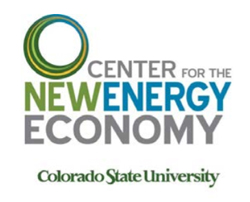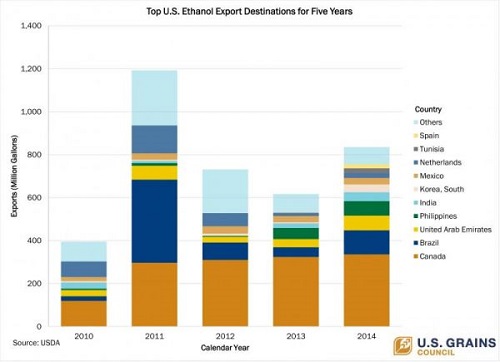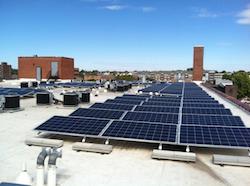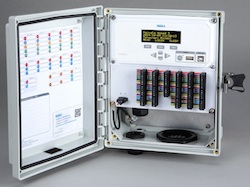 The National Geothermal Summit is around the corner, taking place June 3-4, 2015 in Reno, Nevada. On tap – key players in the geothermal industry will discuss the outlook for geothermal power in the Silver State and beyond under the theme: “Geothermal Policies as Stimulus for Economic Growth and Environmental Quality”. The annual event is put on by the Geothermal Energy Association (GEA) and attendees will hear from Councilwoman Naomi Duerr, Reno City Council; Paul Thomsen, director, Nevada Governor’s Office of Energy; and, John Ruhs, acting state director, Bureau of Land Management Nevada State Office; among many other influential members of the sector.
The National Geothermal Summit is around the corner, taking place June 3-4, 2015 in Reno, Nevada. On tap – key players in the geothermal industry will discuss the outlook for geothermal power in the Silver State and beyond under the theme: “Geothermal Policies as Stimulus for Economic Growth and Environmental Quality”. The annual event is put on by the Geothermal Energy Association (GEA) and attendees will hear from Councilwoman Naomi Duerr, Reno City Council; Paul Thomsen, director, Nevada Governor’s Office of Energy; and, John Ruhs, acting state director, Bureau of Land Management Nevada State Office; among many other influential members of the sector.- PSI Repair Services, Inc., a subsidiary of Phillips Service Industries and leading independent service provider (ISP) to the wind energy industry, announced today that it recently shipped its 20,000th repaired wind turbine part to a prominent wind energy company. Since 2009, PSI has provided economical repairs, as well as industry-leading engineering services that include product upgrades, for the largest wind farms in the United States.
- Golden Age Resources, Inc. has announced construction plans and financing on Cogeneration Pilot Project. Thomas Wolff, Vice President of Golden Age Resources Mexico S de R.L. noted, “The 100Kw Biomass to Energy Plan will build as a scalable WTE (Waste to Energy) Plant with a 2 Mw/hour output by using organic municipal and/or sisal waste with planned implementation of the new fuel cell technology provided from our Strategic Alliance Partner GEI Global Energy Corp.” As soon as the plant reaches initial planned capacity of 2mW/Hr the total energy produced will be 17.52 gW/Yr. The energy generated from the WTE plant will be sold to the Commission Federal de Electricidad with a signed 20 year PPA.
- Tri Global Energy, the utility-scale renewable energy company with wind farm projects located in Texas and New Mexico, leads Texas as the developer on nearly one quarter of all wind energy projects currently under construction in the state, according to the Q1 2015 Market Report from the American Wind Energy Association (AWEA). The U.S. wind energy industry is in the middle of a near record expansion, with over 13,600 MW of capacity in construction at 100 sites in 23 states, according to AWEA’s Q1 2015 Market Report.
Know the Down Low on RPS Legislation
 There is a lot of activity happening throughout the United States with respect to Renewable Portfolio Standards (RPS) legislation for the year. To keep people informed, the Center for the New Energy Economy (CNEE) has published a Summary of State Renewable Portfolio Standard Legislation in 2015 brief. To date, 87 distinct bills have been introduced in 32 states although only two bills have actually been enacted.
There is a lot of activity happening throughout the United States with respect to Renewable Portfolio Standards (RPS) legislation for the year. To keep people informed, the Center for the New Energy Economy (CNEE) has published a Summary of State Renewable Portfolio Standard Legislation in 2015 brief. To date, 87 distinct bills have been introduced in 32 states although only two bills have actually been enacted.
The brief categorizes the bills into three categories:
- Rollback: includes outright repeals, reductions to targets delays in target dates, exceptions for utilities and bills to extend eligibility for non-renewable fuels or existing large capacity hydroelectric resources;
- Increase: would create a larger market by expanding renewable generation targets, creating new carve-outs or requiring compliance by additional utility-types; and
- Modification: addresses the mechanics of how an RPS program is implemented.
Here is the topline for 2015:
- To date, RPS legislation has been introduced in 32 states. Of the 87 bills, only two have been enacted. A bill in West Virginia repealed the state’s standard and legislation in New Mexico enacted a modification to include a new definition for thermal energy and include Renewable Energy Credits (RECs) to be issued to rural electric cooperatives for generating thermal energy from geothermal resources.
- The percentage shares by category of legislation have shifted over the last three years. RPS increase legislation was more common in 2015 as a percentage of all introduced legislation, than in 2013 and 2014.
- Legislation to increase or rollback an RPS does not appear to be correlated with state policy target dates.
- The most common policy type continues to be modifications to existing RPS policies with revisions to resource eligibility clauses have making up the majority of these bills for the past three years.
Many states’ legislative sessions are still underway and the Center for the New Energy Economy keeps real-time track of changes. Click here to download the brief.
US Ethanol Getting Exported to More Markets
A few years ago, almost all of U.S. ethanol went to Brazil, Canada and the European Union. But this article from the National Corn Growers Association says new information from the U.S. Grains Council shows just how wide the market has grown.

Exports to the United Arab Emirates, the Philippines and India experienced the strongest growth in 2014. While the UAE is largely importing U.S. ethanol to blend with its gasoline that is later re-exported, and India is importing for industrial purpose, the Philippines has a blend mandate in place. Domestic production in the Philippines has been unable to meet its 10 percent blend mandate making imports necessary.
Currently, the United States has a 55 percent market share in the Philippines and the Council is hopeful there is room to capture more. To help nurture this market, the Council and its partners, Renewable Fuels Association, Growth Energy and USDA’s Foreign Agricultural Service, have planned a busy summer with missions heading to the Philippines and other growing markets like China, Indonesia, India and Japan.
St. Louis Re-Use Dev Features Solar
I love the concept of re-use in terms of living spaces. I live in a former tea manufacturing facility dating back to the mid-1800s and integrating original features of the building give my loft a unique and cool character. While this is an ongoing trend, not many of the refurb buildings in the Midwest are featuring renewable energy. (I wish mine did.) But this one has it all – the Laclede Lofts based in St. Louis, Missouri.
The adaptive-resue project has a cool aura and uses various green features including high-efficiency appliances and light fixtures, but it also features a 250 kilowatt solar array on the roof that generates more than half of the electricity used in the building’s common areas. This project is a joint venture between Universatile Development and Rothschild Development redeveloped the former pharmaceutical factory, located near St. Louis University.
 Jeff Winzerling, president of Universatile Development, said, “We estimated, for the course of a year, the total electrical usage for everything in the common areas: parking lot lights, lobby and hallway air-conditioning, elevator, gate opener, and security system. Even by the more conservative production projection, the array is producing 62% of our usage needs.”
Jeff Winzerling, president of Universatile Development, said, “We estimated, for the course of a year, the total electrical usage for everything in the common areas: parking lot lights, lobby and hallway air-conditioning, elevator, gate opener, and security system. Even by the more conservative production projection, the array is producing 62% of our usage needs.”
Microgrid Solar engineers worked with the developer to explore a few different options for deploying solar power at the art deco building, which the Pfeiffer Pharmaceutical Company constructed in 1946 to house its offices, laboratories, manufacturing, and warehouse. In the end, the developer settled upon the simplest solution: a single 25kW array consisting of 98 solar panels with microinverters connected to the building’s common area meter. Winzerling added, “It would have been really cool to have some solar-powered apartments, but the complexity and expense would have been much greater, so we opted for a solar-powered building instead.”
Microgrid CEO, Rick Hunter, added, “This is a unique project, utilizing solar on a historic renovation project and an apartment building – you just don’t see this sort of thing very often, due to the challenges involved. We are thrilled to have been a part of the project.”
Another cool feature – a link was added to the building’s website that allows building residents and others to monitor the panels’ production over time, as well as to see the electrical output converted into reduced carbon dioxide emissions, either in trees planted or miles not driven.
Eseye Joins The New Motion EV Family
Eseye is now supplying connectivity services to The New Motion, who own more than 14,000 EV charging stations, making the company one of the largest and fastest growing Electric Vehicle (EV) charging networks in Europe. Research firm TechNavio is estimating the CAGR for the global electric vehicle charger market of 28.8 percent.
According to Eseye, The New Motion has benefited from their  expertise in supplying connectivity that is tailored to the customer. For example, all services required for payment and charging credit will be handled by Eseye. The New Motion are said to be very happy with the responsiveness and helpfulness of Eseye’s technical support staff, with all support provided from one central help desk.
expertise in supplying connectivity that is tailored to the customer. For example, all services required for payment and charging credit will be handled by Eseye. The New Motion are said to be very happy with the responsiveness and helpfulness of Eseye’s technical support staff, with all support provided from one central help desk.
Eseye says its roaming, mobile network-agnostic Multi IMSI AnyNet SIM provides reliable mobile network coverage in even the most remote and challenging locations. In addition, all IMSIs are Over-The-Air (OTA) re-programmable which means Eseye is able to help The New Motion future proof the solution without the need to return to site to swap the SIM cards out if they need to switch mobile network providers. This is an important consideration for The New Motion, with Remi Caron, their chief technology and innovation officer, saying, “With each EV charge station expected to have a lifespan of 5-10 years, it is imperative that our suppliers understand our need to have reliable and future proof solutions.”
The New Motion is going through expansion throughout Europe, where charge points and charging services are already available to electric car owners. Currently The New Motion charge card can be used at charge points located in Holland, Belgium, Germany, Luxembourg, Austria, the UK and Norway.
Ethanol Industry Launches RFS Campaign
 The ethanol industry through Fuels America is launching a major advertising campaign in the nation’s capitol this week urging support for the Renewable Fuel Standard (RFS).
The ethanol industry through Fuels America is launching a major advertising campaign in the nation’s capitol this week urging support for the Renewable Fuel Standard (RFS).
Renewable Fuels Association (RFA) president and CEO Bob Dinneen says the campaign asks the EPA to choose whether to reward the oil industry for refusing to fulfill its obligations under the law, or to get the RFS back on track by proposing adequate Renewable Volume Obligation (RVO) levels. “We intend to make sure that the (EPA) administrator, members of Congress, and the president himself understand the very clear choice that will be made with this impending RVO decision,” said Dinneen during a morning press conference announcing the new campaign.
The campaign includes television advertising during morning news, Sunday morning talk shows, and cable television, as well as a digital campaign that includes a Politico homepage takeover, a Real Clear Politics Energy takeover, and banner ads on Roll Call’s Energy page.
“The question is, is EPA going to – for the first time – waive the RFS if the oil industry refuses to distribute renewable fuels?” said Advanced Ethanol Council executive director Brooke Coleman.
The campaign is in response to a letter from oil industry organizations to the EPA, and a responsive letter from biofuels industry leaders to the EPA last week. The letters agree on one thing: the EPA has a choice to make. Either choose to reward the oil industry for refusing to fulfill its obligations under the law, or choose to get the Renewable Fuel Standard (RFS) back on track by proposing Renewable Volume Obligation (RVO) levels that comport with the spirit and intent of the law.
Fuels America Campaign LaunchVaisala Launches Nomad 3 for Wind Data
Vaisala has launched the Nomad 3 Data Logger, a flexible and highly portable data management device that makes wind measurement easier and more economical for developers and operators around the globe says the company. With intermittent issues around wind energy, early siting and ongoing investment and operational decisions are based on wind resource data and have a direct link to success of a wind project.
 According to Vaisala, current data loggers on the market are difficult to install and operate. They also cite current data technologies often fall short when it comes to performance in rough, remote locations and cross-compatibility with broad range wind measurement sensors employed throughout the renewable energy industry.
According to Vaisala, current data loggers on the market are difficult to install and operate. They also cite current data technologies often fall short when it comes to performance in rough, remote locations and cross-compatibility with broad range wind measurement sensors employed throughout the renewable energy industry.
The Nomad 3 Data logger has been widely tested and the company’s first data logger was developed back in 1981. The new device, however, has been completely re-engineered with the current challenges of developers and operators in mind. According to the company, the Nomad 3 offers a Linux operating system, and a smaller, lighter design while remaining incredibly flexible and straightforward to use. It is compatible with all market-leading wind sensors, and is ideally suited for hard to reach regions of emerging markets like South America, Asia, and Africa, since it can be conveniently carried in a backpack to sites without road access.
The Nomad 3 Data logger also features wireless connectivity and Vaisala’s SkyServe wind data management service – a secure web portal that offers a range of fleet management tools. Online operating systems also make it accessible to any web-enabled device, such as a smartphone, tablet, or computer.
A number of partners and government laboratories have already started using the Nomad 3 as beta clients at locations around the world. These include: NIWE (India’s National Institute of Wind Energy formerly known as C-WET), Saiwind, and WISE Information Sentinel.
BioEnergy Bytes
 Waaree Energies Ltd. has dispatched over 1000 solar lanterns to be freely distributed to the earthquake affected families in Nepal. Once completely charged, these solar lanterns can work up to eight hours and they can also be used to charge mobile phones. This would provide the much needed respite to those who are stressed due to non-availability of power. Most of the earthquake affected areas are still under darkness, while power restoration work is underway.
Waaree Energies Ltd. has dispatched over 1000 solar lanterns to be freely distributed to the earthquake affected families in Nepal. Once completely charged, these solar lanterns can work up to eight hours and they can also be used to charge mobile phones. This would provide the much needed respite to those who are stressed due to non-availability of power. Most of the earthquake affected areas are still under darkness, while power restoration work is underway.- GlobalData’s report, “Wind Regains Momentum in 2014 and Industry Outlook Improves,” reveals that the global wind turbine market is expected to see increased growth in the coming years. In 2014, the global market experienced substantial improvement, reaching nearly 45% growth over 2013 in terms of annual installations, or 52 GW. GlobalData forecasts the cumulative wind installed capacity to reach 425 GW in 2015, an increase of 14%, as the global new wind turbine order intake rose by 44% in Q1 2015 over Q1 2014, or an 8% increase over Q4 2014.
- The Waste to Wisdom (W2W) project has launched a new website highlighting the 3-year effort and its objective to make better use of forest residues from timber harvests and thinning. W2W is funded by a $5.88 million grant from the DOE and is led by Humboldt State University with assistance from 15 regional partners. The grant is part of the Biomass Research and Development Initiative. A key focus of the new website is to outline how the project addresses a core problem surrounding forest residues.
- Three central New Jersey green energy companies have joined forces to develop and operate solar projects that make businesses and communities more resilient to power failures. Called the Resilient Solar Alliance (RSA), the joint venture provides power from clean energy systems at costs lower than available through traditional power sources. RSA makes innovative solar/battery hybrid energy systems that utilize state-of-the-art software, technology and design.
Joule CO2-to-Ethanol Gets Financing, US & Europe Specs
 Renewable energy maker Joule has secured $40 million for its carbon dioxide-to-ethanol plant and has the green fuel meeting U.S. and European specifications. The company says the money will help build a staged industrialization of its patented, reverse-combustion process, including the near-term expansion of Joule’s production field in Hobbs, New Mexico and a longer-term build-out of a 1,000-acre plant to begin in 2017 able to produce 25 million gallons of ethanol per year.
Renewable energy maker Joule has secured $40 million for its carbon dioxide-to-ethanol plant and has the green fuel meeting U.S. and European specifications. The company says the money will help build a staged industrialization of its patented, reverse-combustion process, including the near-term expansion of Joule’s production field in Hobbs, New Mexico and a longer-term build-out of a 1,000-acre plant to begin in 2017 able to produce 25 million gallons of ethanol per year.
“In the past six months alone, Joule has achieved rapid progress and impressive results that position the company well for industrialization. This progress will be bolstered by the newly committed funds and the continued support from our shareholders and strategic partners, including Audi,” said Serge Tchuruk, President and CEO of Joule. “Joule’s CO2-recycled fuel is on track to become a real answer for carbon neutrality. It provides a solution which is both practical and economical for global mobility and it can be implemented in the short term.”
“The call for global decarbonization is increasingly making headlines, and Joule is at the forefront of a CO2 recycling movement that can both reduce industrial emissions and generate economic growth,” said Noubar Afeyan, Co-Founder and Chairman of Joule and Senior Managing Partner and CEO of Flagship Ventures. “The company has proven the industrial viability of its approach and, with the strong new leadership team in place, is rapidly advancing towards market introduction within the next few years.”
Third-party testing of Joule’s ethanol meets the following standards in the U.S. and Europe, respectively:
– American Society for Testing and Materials (ASTM) D4806 – Denatured fuel ethanol for blending with gasolines for use as automotive spark-ignition engine fuel
– German Institute for Standardization (DIN) EN 15376 – Ethanol as a blending component for petrol
Joule wants to use the meeting of the standard to get new government approvals needed for commercialization of its ethanol fuel.
SheerWind Licenses Wind Tech in Denmark
SheerWind Inc. has signed a licensing agreement that will allow its technology to be marketed and deployed in Denmark. The agreement will allow wind-power developer E-Venturi to introduce SheerWind’s INVELOX wind delivery system. The first pilot project is expected to be built in Denmark before the end of the year.
E-Venturi, based in Slagelse, Denmark, will be the first company to market SheerWind’s technology in Europe. Denmark leads the world in wind energy penetration, with 39.1 percent of its electrical consumption coming from wind power. The Danish government plans to quadruple wind power production by 2050 and is pursuing a goal of complete independence from fossil fuels.“We are thrilled to have the world’s wind leader distributing our technology. This is incredible validation of our technology and we look forward to a prosperous relationship that benefits both our countries for years to come,” said George Manos, the president of SheerWind.
According to SheerWind, the INVELOX technology is a cost-effective, high-performance alternative to conventional wind technology. The system uses no above-ground propellers. Rather, it employs a funnel-driven system that captures the wind and brings it to ground-level power turbines and rotors for safer, easier and cheaper operation and maintenance. The technology is safe for humans and wildlife, requires less maintenance than conventional wind systems, and produces more electricity per dollar invested than conventional systems, adds SheerWind.
“Denmark has a long history of introducing ground-breaking wind technology, and we are pleased to continue that tradition by making available within our company SheerWind’s better way to harvest wind energy,” added Lars Lindebjerg Peterson, the CEO of E-Venturi. “We plan to market this innovative solution to some of the world’s leaders in renewable and environmental advancements, and expect it to aid Denmark in reaching its renewable energy goals.”


